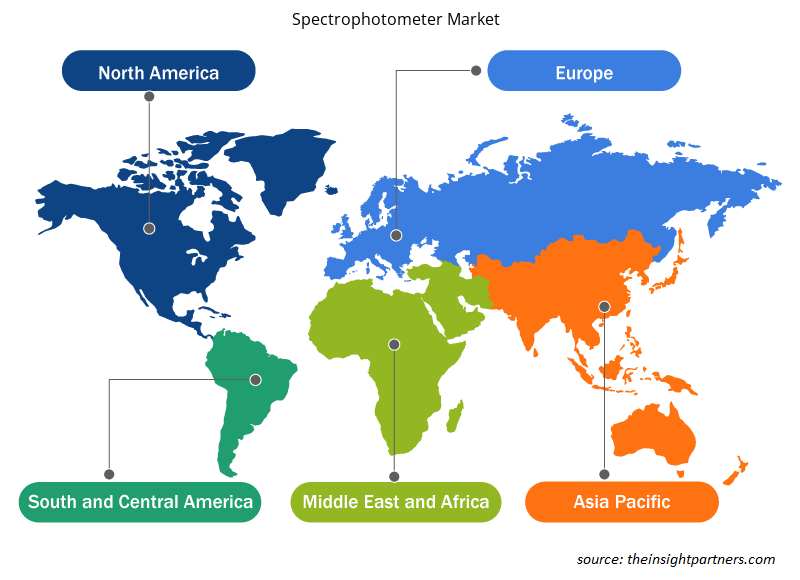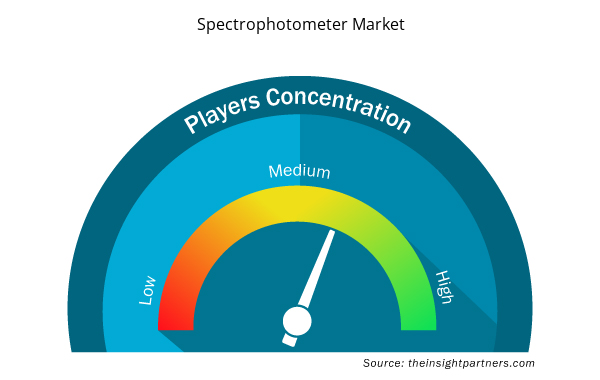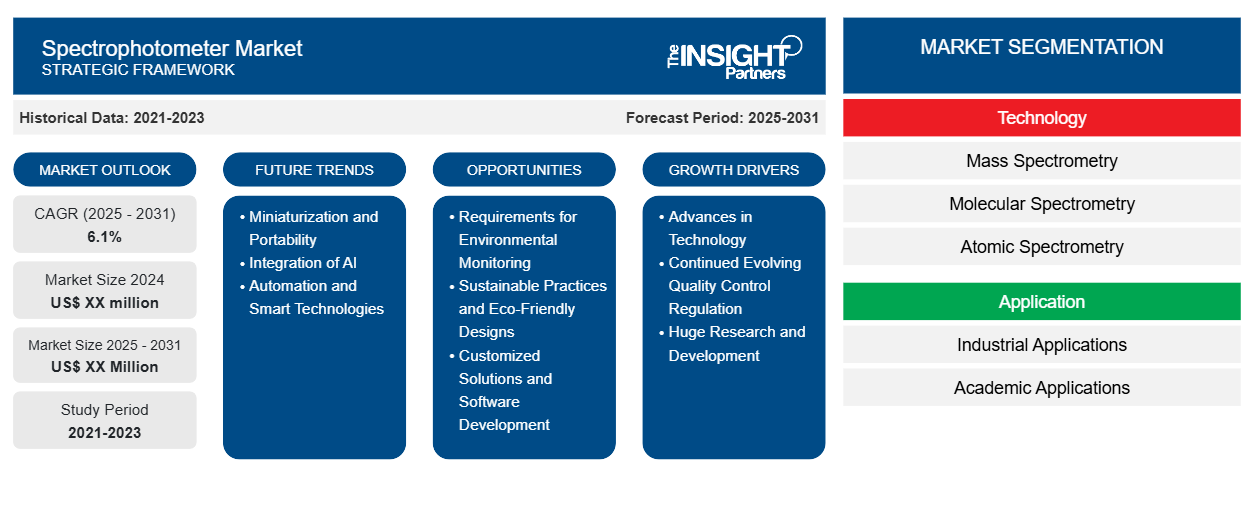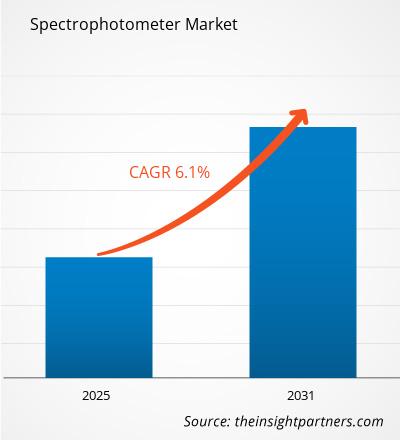Der Spektralphotometer-Markt wird voraussichtlich von 2023 bis 2031 eine durchschnittliche jährliche Wachstumsrate (CAGR) von 6,1 % verzeichnen, wobei die Marktgröße von XX Millionen US-Dollar im Jahr 2023 auf XX Millionen US-Dollar bis 2031 wachsen wird.
Der Bericht ist nach Technologie (Massenspektrometrie, Molekularspektrometrie, Atomspektrometrie) segmentiert. Der Bericht präsentiert außerdem Analysen basierend auf der Anwendung (industrielle Anwendungen, akademische Anwendungen). Darüber hinaus ist er basierend auf dem Endbenutzer (Biotech- und Pharmaunternehmen, Forschungsinstitute, Sonstige) segmentiert. Die globale Analyse ist weiter auf regionaler Ebene und nach wichtigen Ländern aufgeschlüsselt. Der Bericht bietet den Wert in USD für die oben genannte Analyse und die Segmente.
Zweck des Berichts
Der Bericht „Spectrophotometer Market“ von The Insight Partners zielt darauf ab, die aktuelle Situation und das zukünftige Wachstum sowie die wichtigsten treibenden Faktoren, Herausforderungen und Chancen zu beschreiben. Dies wird verschiedenen Geschäftspartnern Einblicke geben, wie zum Beispiel:
- Technologieanbieter/-hersteller: Um die sich entwickelnde Marktdynamik zu verstehen und die potenziellen Wachstumschancen zu kennen, damit sie fundierte strategische Entscheidungen treffen können.
- Investoren: Durchführung einer umfassenden Trendanalyse hinsichtlich der Marktwachstumsrate, der finanziellen Marktprognosen und der Chancen entlang der Wertschöpfungskette.
- Regulierungsbehörden: Zur Regulierung von Richtlinien und Überwachungsaktivitäten auf dem Markt mit dem Ziel, Missbrauch zu minimieren, das Vertrauen der Anleger zu bewahren und die Integrität und Stabilität des Marktes aufrechtzuerhalten.
Spektralphotometer Marktsegmentierung
Technologie
- Massenspektrometrie
- Molekulare Spektrometrie
- Atomspektrometrie
Anwendung
- Industrielle Anwendungen
- Akademische Anwendungen
Endbenutzer
- Biotech- und Pharmaunternehmen
- Forschungsinstitute
- Sonstiges
Geographie
- Nordamerika
- Europa
- Asien-Pazifik
- Süd- und Mittelamerika
- Naher Osten und Afrika
Geographie
- Nordamerika
- Europa
- Asien-Pazifik
- Süd- und Mittelamerika
- Naher Osten und Afrika
Passen Sie diesen Bericht Ihren Anforderungen an
Sie erhalten kostenlos individuelle Anpassungen an jedem Bericht, einschließlich Teilen dieses Berichts oder einer Analyse auf Länderebene, eines Excel-Datenpakets sowie tolle Angebote und Rabatte für Start-ups und Universitäten.
- Holen Sie sich die wichtigsten Markttrends aus diesem Bericht.Dieses KOSTENLOSE Beispiel umfasst eine Datenanalyse von Markttrends bis hin zu Schätzungen und Prognosen.
Wachstumstreiber auf dem Spektralphotometer-Markt
- Technologische Fortschritte: Technologische Entwicklungen wie miniaturisierte, tragbare und benutzerfreundliche Spektralphotometer verändern die Marktlandschaft. Fortschritte bei Vor-Ort-Tests mit Echtzeit-Datenerfassung machen Spektralphotometer für den Feldeinsatz in der Landwirtschaft, Lebensmittelsicherheit und klinischen Diagnostik anwendbar und eröffnen damit einen noch breiteren Anwendungsbereich in allen Sektoren.
- Ständige Weiterentwicklung der Qualitätskontrollvorschriften: Steigende Qualitätskontrollstandards in der Fertigung und in Laboren erfordern Spektralphotometer. In den Bereichen Lebensmittel und Getränke, Pharmazeutika und Kosmetika müssen die Produkte strenge Testverfahren durchlaufen, um die Vorschriften einzuhalten. Daher investieren sie in hochmoderne spektrophotometrische Lösungen, die Qualität, Sicherheit und einheitliche Analysen ihrer Produkte gewährleisten.
- Umfangreiche Forschung und Entwicklung: Das bedeutende Wachstum in den Bereichen Pharmazie, Biotechnologie und Umweltwissenschaften hat die Nachfrage auf dem Spektralphotometermarkt angeheizt. Diese Sektoren erfordern immer genauere quantitative Analysen, und man verlässt sich auf fortschrittliche Spektralphotometer, da sie genauere Daten zur Arzneimittelformulierung, Überwachung und Qualitätskontrolle liefern, was ihre Anwendungsmöglichkeiten in den meisten Forschungseinrichtungen und Branchen erweitert.
Spektralphotometer Markt Zukunftstrends
- Miniaturisierung und Portabilität: Der Fortschritt der Miniaturisierung hat zu einem Trend zu tragbaren Spektralphotometern geführt, die Analysen vor Ort im Feld ermöglichen. Forscher und Fachleute können Echtzeitmessungen direkt vor Ort durchführen, was den Zugang zu solchen Anwendungen in der Umweltüberwachung, Lebensmittelsicherheit oder sogar klinischen Diagnostik viel einfacher und bequemer macht.
- Integration von KI: Integration mit künstlicher Intelligenz: Künstliche Intelligenz und vor allem die Integration von maschinellem Lernen in die Spektrophotometrie sind heute ein aufkommender Trend. KI-Algorithmen können komplexe Datenmuster analysieren und so ihre Genauigkeit und Vorhersagekraft verbessern. Sie verbessern die Effizienz der Entscheidungsfindung in Laboren und industriellen Anwendungen weiter, indem sie effizientere Analysen und bedarfsgerechte, maßgeschneiderte Lösungen bieten.
- Automatisierung und intelligente Technologien: In fast allen Laboren wird heute mehr Automatisierung eingesetzt. Im Hinblick auf die Integration automatisierter Arbeitsabläufe werden daher zunehmend intelligente Spektralphotometer benötigt. Diese bieten vor allem einen verbesserten Durchsatz und weniger menschliche Fehler, während sie gleichzeitig einen Fernzugriff auf diese Geräte ermöglichen. Dies ist besonders nützlich in Plattformen mit hohem Volumen wie pharmazeutischen und klinischen Laboren, in denen Effizienz von größter Bedeutung ist.
Marktchancen für Spektralphotometer
- Anforderungen an die Umweltüberwachung: Das Umweltbewusstsein ist mit der Zeit gewachsen; daher besteht eine größere Nachfrage nach effektiven Überwachungslösungen. In dieser Hinsicht sind Spektralphotometer von Bedeutung für die Überwachung der Wasserqualität, der Luftschadstoffe und der Bodenzusammensetzung, um die Einhaltung von Vorschriften und Initiativen zur Nachhaltigkeit sicherzustellen. Diese intensive Konzentration auf den Umweltschutz erhöht den Einsatz auf dem Spektralphotometermarkt erheblich und treibt Innovation und Wachstum in der Branche voran.
- Nachhaltige Praktiken und umweltfreundliche Designs: Unternehmen sind bestrebt, umweltfreundliche Spektralphotometer zu entwickeln, da nachhaltige Lebensweisen immer mehr im Mittelpunkt stehen. Dieser Fokus wird durch die Verwendung nachhaltiger Materialien und energieeffizienter Technologien im Design erreicht. Solche Erfindungen reduzieren sogar die negativen Auswirkungen der Produkte auf die Umwelt und erfüllen gleichzeitig die zunehmende Nachfrage nach umweltfreundlichen Lösungen in Forschung und Industrie, wodurch sie das Gewissen umweltbewusster Verbraucher ansprechen.
- Maßgeschneiderte Lösungen und Softwareentwicklung: Die Nachfrage nach maßgeschneiderten Lösungen und fortschrittlicher Software in der Spektrophotometrie steigt zunehmend. Die Entwicklung maßgeschneiderter Softwareanwendungen ist strategisch wettbewerbsfähig, da sie die Anforderungen von Branchen mit kundenspezifischen Anforderungen erfüllen kann. Intuitive Schnittstellen, umfassende Datenanalyse und einfache Integration mit vorgefertigten Softwareanwendungen können dem Hersteller zugute kommen, indem sie die Kundenzufriedenheit steigern und den Markt durchdringen.
Regionale Einblicke in den Spektralphotometermarkt
Die regionalen Trends und Faktoren, die den Spektralphotometer-Markt im Prognosezeitraum beeinflussen, wurden von den Analysten von Insight Partners ausführlich erläutert. In diesem Abschnitt werden auch die Marktsegmente und die Geografie des Spektralphotometer-Marktes in Nordamerika, Europa, im asiatisch-pazifischen Raum, im Nahen Osten und Afrika sowie in Süd- und Mittelamerika erörtert.

- Holen Sie sich die regionalspezifischen Daten für den Spektralphotometermarkt
Umfang des Spektralphotometer-Marktberichts
| Berichtsattribut | Details |
|---|---|
| Marktgröße im Jahr 2023 | XX Millionen US-Dollar |
| Marktgröße bis 2031 | XX Millionen US-Dollar |
| Globale CAGR (2023 - 2031) | 6,1 % |
| Historische Daten | 2021-2022 |
| Prognosezeitraum | 2024–2031 |
| Abgedeckte Segmente | Nach Technologie
|
| Abgedeckte Regionen und Länder | Nordamerika
|
| Marktführer und wichtige Unternehmensprofile |
|
Dichte der Marktteilnehmer für Spektralphotometer: Die Auswirkungen auf die Geschäftsdynamik verstehen
Der Spektralphotometer-Markt wächst rasant, angetrieben durch die steigende Endverbrauchernachfrage aufgrund von Faktoren wie sich entwickelnden Verbraucherpräferenzen, technologischen Fortschritten und einem größeren Bewusstsein für die Vorteile des Produkts. Mit steigender Nachfrage erweitern Unternehmen ihr Angebot, entwickeln Innovationen, um die Bedürfnisse der Verbraucher zu erfüllen, und nutzen neue Trends, was das Marktwachstum weiter ankurbelt.
Die Marktteilnehmerdichte bezieht sich auf die Verteilung von Firmen oder Unternehmen, die in einem bestimmten Markt oder einer bestimmten Branche tätig sind. Sie gibt an, wie viele Wettbewerber (Marktteilnehmer) in einem bestimmten Marktraum im Verhältnis zu seiner Größe oder seinem gesamten Marktwert präsent sind.
Die wichtigsten auf dem Spektralphotometer-Markt tätigen Unternehmen sind:
- Agilent Technologies, Inc.
- Thermo Fisher Scientific
- Hitachi, Ltd.
- Shimadzu Corporation
- PerkinElmer Inc.
Haftungsausschluss : Die oben aufgeführten Unternehmen sind nicht in einer bestimmten Reihenfolge aufgeführt.

- Überblick über die wichtigsten Akteure auf dem Spektralphotometer-Markt
Wichtige Verkaufsargumente
- Umfassende Abdeckung: Der Bericht deckt die Analyse von Produkten, Dienstleistungen, Typen und Endbenutzern des Spektralphotometer-Marktes umfassend ab und bietet einen ganzheitlichen Überblick.
- Expertenanalyse: Der Bericht basiert auf dem umfassenden Verständnis von Branchenexperten und Analysten.
- Aktuelle Informationen: Der Bericht stellt durch die Abdeckung aktueller Informationen und Datentrends Geschäftsrelevanz sicher.
- Anpassungsoptionen: Dieser Bericht kann angepasst werden, um spezifische Kundenanforderungen zu erfüllen und die Geschäftsstrategien optimal anzupassen.
Der Forschungsbericht zum Spektralphotometer-Markt kann daher dabei helfen, die Branchensituation und Wachstumsaussichten zu entschlüsseln und zu verstehen. Obwohl es einige berechtigte Bedenken geben kann, überwiegen die allgemeinen Vorteile dieses Berichts tendenziell die Nachteile.
- Historische Analyse (2 Jahre), Basisjahr, Prognose (7 Jahre) mit CAGR
- PEST- und SWOT-Analyse
- Marktgröße Wert/Volumen – Global, Regional, Land
- Branche und Wettbewerbsumfeld
- Excel-Datensatz


- Hydrocephalus Shunts Market
- Vision Care Market
- Photo Printing Market
- Human Microbiome Market
- Pharmacovigilance and Drug Safety Software Market
- Online Exam Proctoring Market
- Dry Eye Products Market
- Battery Testing Equipment Market
- Cut Flowers Market
- Health Economics and Outcome Research (HEOR) Services Market

Report Coverage
Revenue forecast, Company Analysis, Industry landscape, Growth factors, and Trends

Segment Covered
This text is related
to segments covered.

Regional Scope
North America, Europe, Asia Pacific, Middle East & Africa, South & Central America

Country Scope
This text is related
to country scope.
Häufig gestellte Fragen
Asia Pacific region accounted for the highest CAGR in the spectrophotometer market.
Agilent Technologies Inc, Thermo Fisher Scientific, and Hitachi Ltd are some of the major players operating in the market.
The industrial applications segment accounts for the highest revenue in application segment of the market in 2023.
North America region dominated the spectrophotometer market in 2023.
The major factors driving the spectrophotometer market are:
1. Continued Evolving Quality Control Regulation.
2. Huge Research and Development.
The Spectrophotometer Market is estimated to witness a CAGR of 6.1% from 2023 to 2031
Trends and growth analysis reports related to Life Sciences : READ MORE..
1. Agilent Technologies, Inc.
2. Thermo Fisher Scientific
3. Hitachi, Ltd.
4. Shimadzu Corporation
5. PerkinElmer Inc.
6. Hach
7. Beckman Coulter, Inc.
8. PG Instruments Limited
9. JASCO
10. B&W Tek
The Insight Partners performs research in 4 major stages: Data Collection & Secondary Research, Primary Research, Data Analysis and Data Triangulation & Final Review.
- Data Collection and Secondary Research:
As a market research and consulting firm operating from a decade, we have published and advised several client across the globe. First step for any study will start with an assessment of currently available data and insights from existing reports. Further, historical and current market information is collected from Investor Presentations, Annual Reports, SEC Filings, etc., and other information related to company’s performance and market positioning are gathered from Paid Databases (Factiva, Hoovers, and Reuters) and various other publications available in public domain.
Several associations trade associates, technical forums, institutes, societies and organization are accessed to gain technical as well as market related insights through their publications such as research papers, blogs and press releases related to the studies are referred to get cues about the market. Further, white papers, journals, magazines, and other news articles published in last 3 years are scrutinized and analyzed to understand the current market trends.
- Primary Research:
The primarily interview analysis comprise of data obtained from industry participants interview and answers to survey questions gathered by in-house primary team.
For primary research, interviews are conducted with industry experts/CEOs/Marketing Managers/VPs/Subject Matter Experts from both demand and supply side to get a 360-degree view of the market. The primary team conducts several interviews based on the complexity of the markets to understand the various market trends and dynamics which makes research more credible and precise.
A typical research interview fulfils the following functions:
- Provides first-hand information on the market size, market trends, growth trends, competitive landscape, and outlook
- Validates and strengthens in-house secondary research findings
- Develops the analysis team’s expertise and market understanding
Primary research involves email interactions and telephone interviews for each market, category, segment, and sub-segment across geographies. The participants who typically take part in such a process include, but are not limited to:
- Industry participants: VPs, business development managers, market intelligence managers and national sales managers
- Outside experts: Valuation experts, research analysts and key opinion leaders specializing in the electronics and semiconductor industry.
Below is the breakup of our primary respondents by company, designation, and region:

Once we receive the confirmation from primary research sources or primary respondents, we finalize the base year market estimation and forecast the data as per the macroeconomic and microeconomic factors assessed during data collection.
- Data Analysis:
Once data is validated through both secondary as well as primary respondents, we finalize the market estimations by hypothesis formulation and factor analysis at regional and country level.
- Macro-Economic Factor Analysis:
We analyse macroeconomic indicators such the gross domestic product (GDP), increase in the demand for goods and services across industries, technological advancement, regional economic growth, governmental policies, the influence of COVID-19, PEST analysis, and other aspects. This analysis aids in setting benchmarks for various nations/regions and approximating market splits. Additionally, the general trend of the aforementioned components aid in determining the market's development possibilities.
- Country Level Data:
Various factors that are especially aligned to the country are taken into account to determine the market size for a certain area and country, including the presence of vendors, such as headquarters and offices, the country's GDP, demand patterns, and industry growth. To comprehend the market dynamics for the nation, a number of growth variables, inhibitors, application areas, and current market trends are researched. The aforementioned elements aid in determining the country's overall market's growth potential.
- Company Profile:
The “Table of Contents” is formulated by listing and analyzing more than 25 - 30 companies operating in the market ecosystem across geographies. However, we profile only 10 companies as a standard practice in our syndicate reports. These 10 companies comprise leading, emerging, and regional players. Nonetheless, our analysis is not restricted to the 10 listed companies, we also analyze other companies present in the market to develop a holistic view and understand the prevailing trends. The “Company Profiles” section in the report covers key facts, business description, products & services, financial information, SWOT analysis, and key developments. The financial information presented is extracted from the annual reports and official documents of the publicly listed companies. Upon collecting the information for the sections of respective companies, we verify them via various primary sources and then compile the data in respective company profiles. The company level information helps us in deriving the base number as well as in forecasting the market size.
- Developing Base Number:
Aggregation of sales statistics (2020-2022) and macro-economic factor, and other secondary and primary research insights are utilized to arrive at base number and related market shares for 2022. The data gaps are identified in this step and relevant market data is analyzed, collected from paid primary interviews or databases. On finalizing the base year market size, forecasts are developed on the basis of macro-economic, industry and market growth factors and company level analysis.
- Data Triangulation and Final Review:
The market findings and base year market size calculations are validated from supply as well as demand side. Demand side validations are based on macro-economic factor analysis and benchmarks for respective regions and countries. In case of supply side validations, revenues of major companies are estimated (in case not available) based on industry benchmark, approximate number of employees, product portfolio, and primary interviews revenues are gathered. Further revenue from target product/service segment is assessed to avoid overshooting of market statistics. In case of heavy deviations between supply and demand side values, all thes steps are repeated to achieve synchronization.
We follow an iterative model, wherein we share our research findings with Subject Matter Experts (SME’s) and Key Opinion Leaders (KOLs) until consensus view of the market is not formulated – this model negates any drastic deviation in the opinions of experts. Only validated and universally acceptable research findings are quoted in our reports.
We have important check points that we use to validate our research findings – which we call – data triangulation, where we validate the information, we generate from secondary sources with primary interviews and then we re-validate with our internal data bases and Subject matter experts. This comprehensive model enables us to deliver high quality, reliable data in shortest possible time.


 Holen Sie sich ein kostenloses Muster für diesen Bericht
Holen Sie sich ein kostenloses Muster für diesen Bericht